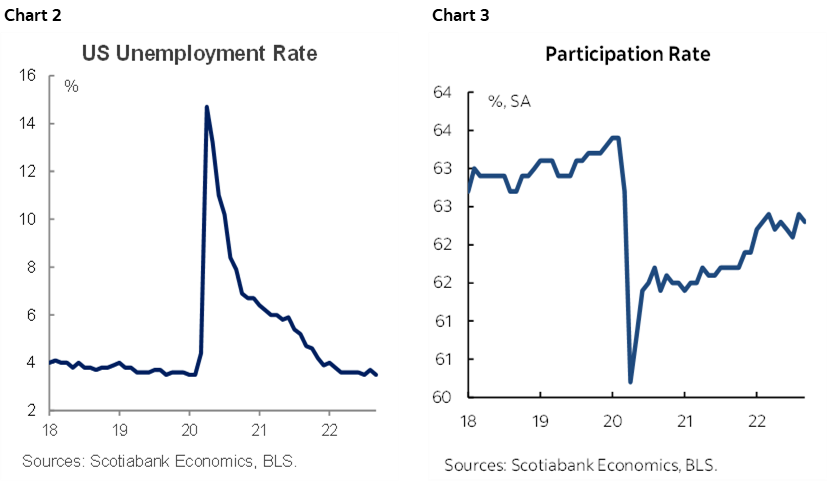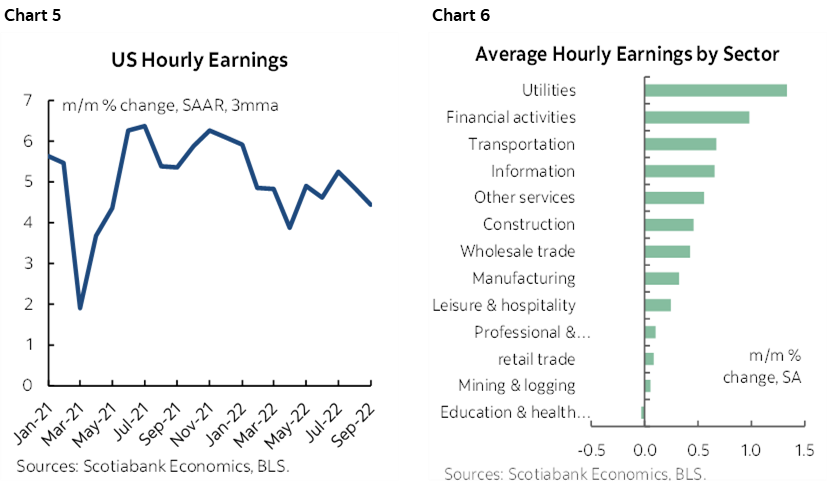- Nonfarm payrolls posted another decent gain…
- ...that keeps labour markets tight...
- ...but momentum is slowing and with more slowing to come
- US Nonfarm payrolls, m/m 000s // UR (%), September, SA:
- Actual: 263 / 3.5
- Scotia: 300 / 3.6
- Consensus: 255 / 3.7
- Prior: 315 / 3.7
It’s getting there. Slowly and one payrolls report at a time, but the pace of job creation in the US economy is gradually cooling. It remains above the pace at which new entrants are in search of jobs and that continues to keep the job market tight. Nevertheless, the cooling pace of job creation and the turning point in JOLTS job openings portend weaker nonfarm payrolls still lie ahead (chart 1).

As evidence of tightness, the unemployment rate—derived from the companion household survey—fell another two-tenths to 3.5% (chart 2) because that survey’s measure of employment growth landed at +204k while 57,000 Americans left the workforce in September and the labour force participation rate slipped a tick to 62.3% (chart 3). The labour force swings have been massive as the prior month saw an entry of 786,000 people in search of work after a net ~410k drop over the prior two months.

The U6 underemployment rate that combines unemployment with measures like folks who are working part-time who would prefer full-time work also fell to 6.7% from 7%. That remains around pre-pandemic lows.
Breadth to the 263k gain in payrolls was soft as a handful of sectors accounted for the majority of it. Education and health were up 90k with leisure and hospitality up 83k while business services added 46k and over half of that came via temp help. See chart 4.

Wage growth held steady at 0.3% m/m or 3.7% at an annualized rate which is similar to the prior month (chart 5). In year-over-year terms, wage growth cooled to 5% from 5.2%. Chart 6 shows the sector breakdown of year-over-year wage gains.

Hours worked were up by 0.2% m/m again. At an annualized rate that leaves hours up by 2.6% q/q at a seasonally adjusted and annualized rate in Q3. This is a little slower than the prior quarter’s 3% expansion (chart 7). Since GDP is an identity defined as hours worked times labour productivity, the ongoing strength in hours worked points to underlying resilience in the domestic economy.

Soooo.....the US figures basically reinforce the cooling job market narrative on a trend basis with likely declines ahead over coming months, but the FOMC is a long, long way from being satisfied that enough labour slack has opened up and will only get that with either a long string of much softer gains below the pace of expansion in the workforce or a string of employment declines
Q1 and Q2 US GDP overstated US economic weakness compared to domestic demand drivers. Hours worked confirm that on the same logic that GDP is hours times productivity. I think US GDP growth turns positive again in Q3 as those distortions shake out somewhat and this expectation is supported by continued gains in hours worked.
Therefore, while inflation is the focus, the return to what we think is about 2% q/q SAAR US real GDP growth will be positively received by the Fed to keep on hiking on.
DISCLAIMER
This report has been prepared by Scotiabank Economics as a resource for the clients of Scotiabank. Opinions, estimates and projections contained herein are our own as of the date hereof and are subject to change without notice. The information and opinions contained herein have been compiled or arrived at from sources believed reliable but no representation or warranty, express or implied, is made as to their accuracy or completeness. Neither Scotiabank nor any of its officers, directors, partners, employees or affiliates accepts any liability whatsoever for any direct or consequential loss arising from any use of this report or its contents.
These reports are provided to you for informational purposes only. This report is not, and is not constructed as, an offer to sell or solicitation of any offer to buy any financial instrument, nor shall this report be construed as an opinion as to whether you should enter into any swap or trading strategy involving a swap or any other transaction. The information contained in this report is not intended to be, and does not constitute, a recommendation of a swap or trading strategy involving a swap within the meaning of U.S. Commodity Futures Trading Commission Regulation 23.434 and Appendix A thereto. This material is not intended to be individually tailored to your needs or characteristics and should not be viewed as a “call to action” or suggestion that you enter into a swap or trading strategy involving a swap or any other transaction. Scotiabank may engage in transactions in a manner inconsistent with the views discussed this report and may have positions, or be in the process of acquiring or disposing of positions, referred to in this report.
Scotiabank, its affiliates and any of their respective officers, directors and employees may from time to time take positions in currencies, act as managers, co-managers or underwriters of a public offering or act as principals or agents, deal in, own or act as market makers or advisors, brokers or commercial and/or investment bankers in relation to securities or related derivatives. As a result of these actions, Scotiabank may receive remuneration. All Scotiabank products and services are subject to the terms of applicable agreements and local regulations. Officers, directors and employees of Scotiabank and its affiliates may serve as directors of corporations.
Any securities discussed in this report may not be suitable for all investors. Scotiabank recommends that investors independently evaluate any issuer and security discussed in this report, and consult with any advisors they deem necessary prior to making any investment.
This report and all information, opinions and conclusions contained in it are protected by copyright. This information may not be reproduced without the prior express written consent of Scotiabank.
™ Trademark of The Bank of Nova Scotia. Used under license, where applicable.
Scotiabank, together with “Global Banking and Markets”, is a marketing name for the global corporate and investment banking and capital markets businesses of The Bank of Nova Scotia and certain of its affiliates in the countries where they operate, including; Scotiabank Europe plc; Scotiabank (Ireland) Designated Activity Company; Scotiabank Inverlat S.A., Institución de Banca Múltiple, Grupo Financiero Scotiabank Inverlat, Scotia Inverlat Casa de Bolsa, S.A. de C.V., Grupo Financiero Scotiabank Inverlat, Scotia Inverlat Derivados S.A. de C.V. – all members of the Scotiabank group and authorized users of the Scotiabank mark. The Bank of Nova Scotia is incorporated in Canada with limited liability and is authorised and regulated by the Office of the Superintendent of Financial Institutions Canada. The Bank of Nova Scotia is authorized by the UK Prudential Regulation Authority and is subject to regulation by the UK Financial Conduct Authority and limited regulation by the UK Prudential Regulation Authority. Details about the extent of The Bank of Nova Scotia's regulation by the UK Prudential Regulation Authority are available from us on request. Scotiabank Europe plc is authorized by the UK Prudential Regulation Authority and regulated by the UK Financial Conduct Authority and the UK Prudential Regulation Authority.
Scotiabank Inverlat, S.A., Scotia Inverlat Casa de Bolsa, S.A. de C.V, Grupo Financiero Scotiabank Inverlat, and Scotia Inverlat Derivados, S.A. de C.V., are each authorized and regulated by the Mexican financial authorities.
Not all products and services are offered in all jurisdictions. Services described are available in jurisdictions where permitted by law.

